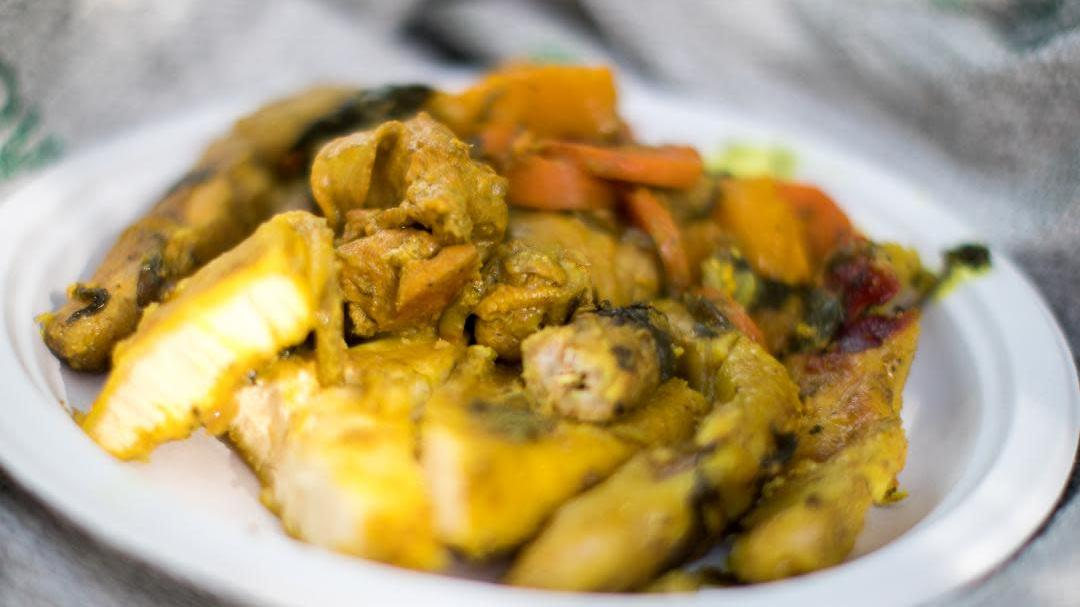In Oil Down, Grenada's National Dish, Spices Come Together For A Greater Cause
The first thing that I noticed when I landed on the Eastern Caribbean island of Grenada was the emerald green landscape, dotted with mountains rising up over the crystalline waves. The second thing that struck me was that Grenada isn't just visually distinctive, it also has a particular aroma. I didn't recognize the spicy, woodsy smell that floated through the air, but I would soon learn that it was nutmeg. An important crop for a country nicknamed the Spice Isle, nutmeg played a lead role in my discovery of Grenada's culinary offerings and the ultimate dish that stole my heart.
For years, I longed to explore Grenada's legendary beaches, waterfalls, and rainforests, but I especially wanted to sample the island's equally notable food; nothing tops a place that offers natural beauty and a rich culinary history. I started with a dune buggy ride through the Annandale Rainforest, where I glimpsed anthuriums and orchids as well as breadfruit and cashew trees. It seemed like wherever I went, from the forests to the beaches and roads, I was never more than a few steps from something edible: fresh ground spices and pepper sauces in the St. George Spice Market, creamy soursop sold on the street, fried bakes and smoked herring at local restaurants, and roast corn and curried chicken roti on the beach. But it was a visit to the Gouyave Nutmeg Processing Station where Grenada's culinary heritage really came together for me.
Since the 18th century, nutmeg has grown in Grenada's fertile soil, along with cinnamon, ginger, and clove. The island produces 40% of the world's nutmeg crop; the spice is so important that it's displayed on the country's flag. As I watched the nutmeg pods being sorted by hand at Gouyave, I was surprised to learn that nutmeg is used for much more than flavoring savory dishes. "Grenada's gold" is used in ice cream, jellies, and even as a pain-relieving lotion and insect repellant. John, a talkative local who worked at the plant, explained that Grenadians take pride in their island's bounty and try to find as many uses for native produce as possible, often layering many ingredients and flavors within a single dish.
"Nothing represents that blend more than our national dish, which is oil down," John said. I had previously heard about this substantial stew, which features island staples like callaloo, breadfruit, and coconut milk, but I had never seen it offered on any menus, even at the restaurants I had visited in Grenada's capital of St. George's. Turns out that although a few eateries serve the dish, it's the kind of home-cooked specialty that's prepared on weekends and on special occasions across the island. It's even cooked over outdoor fire pits with friends on Independence Day (February 7). John, who took pity on my lack of familiarity with oil down, invited me to taste the dish at his grandfather's house in the pretty town of Dunfermline.
In a large house that looked like a gingerbread cottage lined with flowers, I saw a big pot filled with starchy "ground provisions." John explained that the pot had to be big enough for all the ingredients to "swim around." The name "oil down" itself actually comes from the fact that the coconut oil and meat juices settle down at the bottom of the pot. I was served a calabash bowl brimming with a rich turmeric broth (turmeric is referred to in Grenada as saffron) and big pieces of green bananas, breadfruit, and dumplings. "There's no real oil down without dumplings," explained John.

We sat on the veranda with red hibiscus flowers waving in the background as I spooned up the heavy mixture. I tasted the fresh callaloo leaves and the richness of the coconut milk spiced with saffron and pepper. The starchy bananas, breadfruit, and carrots offset the mild spiciness, and the fish and dumplings complemented and intensified all the other flavors. Considering how creamy and hearty it was, I was surprised that I didn't feel overly full as I finished my first bowl and started in on another.
John explained that everyone uses different meat for their oil down. Traditionally, a combination of salted beef or pork (pigtails, snout) and salted fish (mackerel, cod) comprise the base of the recipe, but his version skipped the pork and beef, so it was a little lighter. John's genial grandfather smiled as he pointed out that oil down reflects the green (callaloo), red (carrots), and yellow (saffron) of Grenada's flag. I looked down at the starchy mixture that stuck together in my bowl: the individual colors faded into each other, all the flavors working together in service of the overall dish. Oil down didn't just represent Grenada's local ingredients. It embodied Grenada in other ways, too: something more than the sum of its parts, a testament to the individuals who had made it all that it is.
